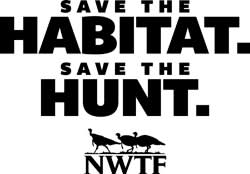Kansas NWTF to Invest $96,000 in Conservation in 2014
National Wild Turkey Federation 03.18.14

National Wild Turkey Federation (NWTF) chapters in Kansas budgeted more than $96,000 to further the new Save the Habitat. Save the Hunt. initiative within the state in 2014.
The NWTF’s Kansas State Chapter board of directors met in Salina, Kansas, to review and allocate funding, which includes $23,500 to support education and outreach efforts in Kansas through JAKES, Women in the Outdoors and Wheelin’ Sportsmen, and local and state scholarships.
“The Save the Habitat. Save the Hunt. initative is supported by our state boards and chapter members,” said Becky Humphries, executive vice president of conservation. “Hunting Heritage Super Fund money is critical to implementing the initiative, and investing in focal landscapes and hunter recruitment.”
The NWTF’s Save the Habitat. Save the Hunt. initiative is a charge that mobilizes science, fundraising and devoted volunteers to give the NWTF more energy and purpose than ever. Through this national initiative, NWTF has committed to raising $1.2 billion to conserve and enhance more than 4 million acres of essential upland wildlife habitat, create at least 1.5 million new hunters and open access to 500,000 new acres for hunting, shooting and outdoor enjoyment. Without hunters, there will be no wildlife or habitat. The NWTF is determined to Save the Habitat. Save the Hunt.
The board of directors also dedicated $73,380 in NWTF funding to the following proposed Hunting Heritage Super Fund projects in 2014, which, when completed, will be matched with more than $2.1 million in partner funding:
- $20,000 to acquire land to add to Tuttle Creek Wildlife Area, to be paid over two years. Project Partners: Kansas Department of Wildlife, Parks and Tourism (KDWPT), Pheasants Forever and seller
- $8,500 to restore grasslands at Clinton, Glen Elder, Hillsdale and Norton wildlife areas. Projects include removing invasive woody species (honey locust, Russian olive and Eastern red cedar) and converting brome to native warm season grasses at Norton Wildlife Area. Project Partners: KDWPT
- $10,000 to support KDWPT’s new Pheasant Initiative centered on Glen Elder and Norton wildlife areas, which promotes pheasant-friendly habitat improvements on public and private land. Project Partners: KDWPT
- $8,900 to restore riparian areas. Projects include planting trees to stabilize banks at Melvern Wildlife Area and Flint Hills National Wildlife Refuge, and removing undesirable tree species from cottonwood stands at Cedar Bluff Wildlife Area. Project Partners: KDWPT, U.S. Fish and Wildlife Service (USFWS), Kansas Forest Service, Eco-Tone Forestry, Kansas Bowhunters and others
- $5,000 to support the NWTF’s Regional Biologist Program. Project Partners: KDWPT, Nebraska Game & Parks Commission, and Nebraska NWTF State Chapter
- $4,230 to support local 4-H Shooting Sports programs in Grant, Lyon and Jefferson counties by purchasing bows, targets and air pistols. Funding also will help Kansas youth travel to compete in the national competition. Project Partners: local 4-H Shooting Sports Programs, state 4-H Shooting Sports Program, various individuals and local organizations
- $3,000 to help Fort Riley purchase a tree saw for use in grassland restoration and forest stand improvement efforts on Fort Riley. Project Partners: Fort Riley (Department of Defense)
- $3,000 to help fund KDWPT’s Spring Walk-In Hunting Access (WIHA) Program to include a Sign-up Incentive Payment in targeted counties to increase landowner enrollment in the spring WIHA program. Project Partners: KDWPT, USFWS
- $2,500 to support Forest Stand Improvement efforts at Douglas State Fishing Lake. Project Partners: KDWPT
- $2,500 to support a Kansas Youth Coordinator position, which focuses on getting more youth outdoors, specifically to hunt and fish. Project Partners: KDWPT, Pheasants Forever and Outdoor Mentors Inc.
- $1,500 to help establish firebreaks and install a solar well to improve grassland health on Jamestown Wildlife Area. Project Partners: KDWPT
- $1,500 to restore grassland on a Walk-In Hunting Area property at Camp Ascension near Toronto, Kansas. Project Partners: KDWPT and Camp Ascension (landowner)
- $1,000 to provide scholarships to annual winners of the Kansas Eco-Meet. Project Partners: KDWPT and others
- $1,000 to match funds of a Ducks Unlimited North American Wetlands Conservation Act grant, which, if secured, will improve habitat, including wetlands, on Neosho Wildlife Area. Project Partners: KDWPT, Ducks Unlimited, local cooperators and landowners
- $750 to create firebreaks that will improve the ability to conduct prescribed burns at Pottawatomie State Fishing Lake #1. Project Partners: KDWPT
For more information, visit www.nwtf.org or contact Melanie Swearingen at mswearingen@nwtf.net or (803) 637-7634.

